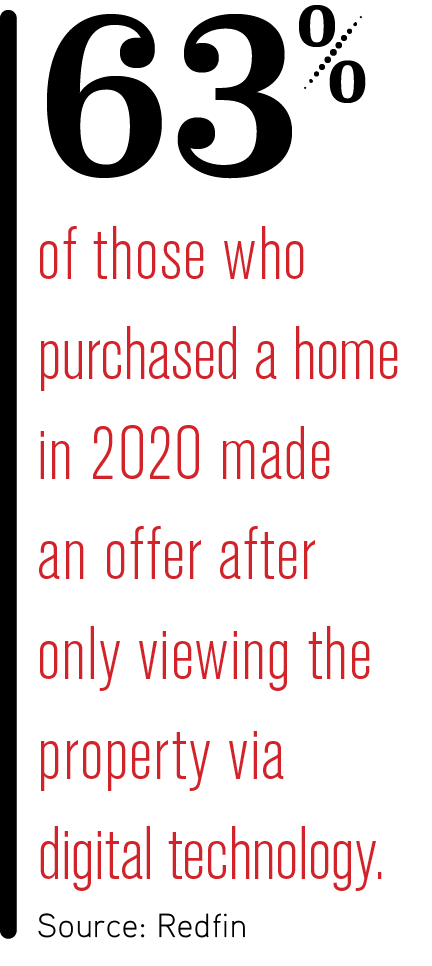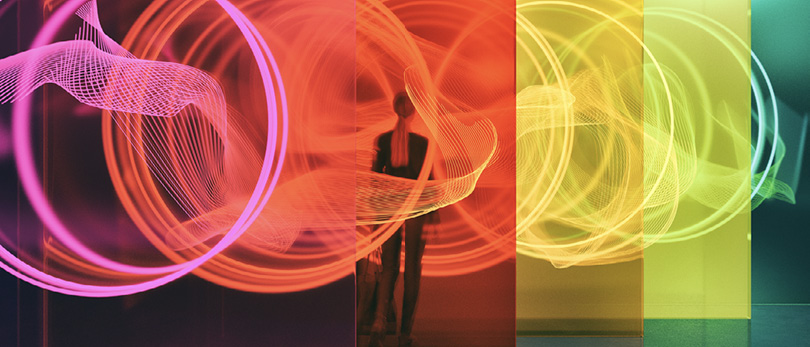Advancements in technology have allowed for agents to offer virtual touring options for buyers and sellers alike
By Donna Shryer
For some time now, the real estate industry has been gradually embracing digital home tours.

Virtual reality, augmented reality and 360-degree 3D virtual tours are all used to create interactive home-shopping experiences. However, it was still the in-person tour that typically sealed the sale.
Then March 2020 hit. In-person home tours came to a screeching halt, and the once-gradual move to a virtual world shifted into warp speed. If the hot 2021 housing market is any indication, many homebuyers haven’t missed in-person viewings. In fact, a Redfin survey reports that 63% of those who purchased a home in 2020 made an offer after only viewing the property via digital technology.
“Before the pandemic, I thought we had maybe a five-year window of opportunity to get onboard with virtual and augmented reality. COVID-19 closed that window,” says Craig Grant, Real Estate Technology Institute CEO and NAR & CRS instructor. “Now the average homebuyer expects to complete almost the entire shopping process from the comfort of their own home. I don’t think that’s going to change.”
For your information
Augmented reality (AR) involves an interactive experience where you digitally add a new layer of virtual content on top of a real-world photograph, video or 360-degree virtual tour. “Think of AR as a way to give the home shopper additional information about an existing space,” explains Matthew Rathbun, CRS, Certified CRS Instructor and executive vice president of Coldwell Banker Elite in Virginia.
The simplest AR practice involves clicking into a free paint store app, like the ones offered by The Home Depot or Sherwin Williams, that lets you digitally paint walls any color the homebuyer desires. Virtual staging, using apps from retailers such as IKEA or Crate & Barrel, is another AR application.
Going a step further, Rathbun creates a virtual 360-degree home tour on a 3D platform, such as Matterport or immoviewer, and then uses AR to boost the tour’s informational value. He digitally places icons over specific elements throughout the tour, like a kitchen’s pro-style range or a bathroom’s low-flow shower head, and when the icon is clicked, a YouTube video pops up, showing off the product. “By adding this extra layer of information, I can point out a home’s unique features or upgraded products that buyers may not recognize or understand when simply viewing the tour on a smartphone.”
As for evolving AR technology, focus on augmented reality smart glasses, says Dogu Taskiran, CEO of Stambol, a VR and AR studio that specializes in the real estate industry. “AR eyewear lets us lay multiple layers of information on top of the physical world to create a 3D environment. I believe that almost every industry will be affected by smart glasses once they become commonplace, and I think the real estate and construction industries will be particularly impacted,” Taskiran adds.
Vuzix, a supplier of smart glasses and AR technology, is currently fine-tuning eyewear that allows real estate agents to hold open houses and tours that are partly virtual and partly in person. As explained on the Vuzix website, the agent dons a pair of smart glasses, initiates a video conference with a client, and as the agent walks through the home, the viewer sees everything the agent sees and can ask questions in real time.
It feels so real
Virtual reality (VR) describes a 3D, computer-generated, interactive environment that feels real but is actually 100% fabricated. By definition, Grant says, you need VR goggles to get the full immersive experience. “A 360-degree 3D tour that you see on a flat computer screen or smartphone is close to VR—and when done right, absolutely effective—but you can’t feel depth, and there’s no interaction with or movement through the digital image. So, it’s not the full virtual reality experience.”
Until recently, high headset costs precluded a robust audience for VR home tours. But that’s changing, Taskiran says. For example, top-rated Oculus goggles come in around $300, which is a price drop from where the headset started. And then there’s the minimalistic Google Cardboard, which cost around $10, and they’re “not bad,” Taskiran says, adding that there may even come a day when agents produce VR home tours for most of their listings and handout cardboard headsets to home shoppers. “You could even print your name and logo on a couple thousand cardboard goggles,” he suggests.
With headsets less of an issue, it may be time to consider producing a VR tour—especially if a property or project doesn’t even exist yet, Taskiran says. “We can create a visual tour that takes you to a condominium on the 24th floor or the 12th floor, with different furnishings, adjusted window views and a genuine sense for square footage. I can see how someone would take a VR tour and say, ‘This is home.’ It feels that real.”
 For homes already built and ready for a new owner, Rathbun says a well-produced VR tour can decrease days on the market and quite possibly put multiple offers on the table. “I’ve seen buyers become emotionally invested in a home after a virtual walk-through. Seeing the home in person almost feels like a formality—if an in-person walk-through is even necessary. If multiple homebuyers take the same VR tour and everyone feels that emotional pull, offers start popping.”
For homes already built and ready for a new owner, Rathbun says a well-produced VR tour can decrease days on the market and quite possibly put multiple offers on the table. “I’ve seen buyers become emotionally invested in a home after a virtual walk-through. Seeing the home in person almost feels like a formality—if an in-person walk-through is even necessary. If multiple homebuyers take the same VR tour and everyone feels that emotional pull, offers start popping.”
As for what’s next for virtual reality, Rathbun feels that it’s going to be audio and video implanted into the virtual process. “So, when I put on the VR headset for a home tour and I walk toward the backyard, I hear the pond gurgling, and I see the koi fish swimming in the pond. It really puts you there—in the home—even though the actual address may be halfway across the country,” Matthew says.
As the U.S. reopens and flows toward some sort of normalcy, will homebuyers continue to want the information-rich augmented and virtual reality experiences? Taskiran says yes, and his expanding client list drives that reply. “We first started working with real estate agents back in 2015, and our business has doubled every year since. So the interest was there—and growing—long before the pandemic. Sure, COVID-19 sped things up, but now that consumers understand the convenience of digitally shopping for their new home, it’s an experience that, I think, everyone will continue to expect.”
For more on virtual touring, check our the recording “The Power of Virtual Tours” on CRS.com/catalogsearch.
Photo: iStock.com/piranka








